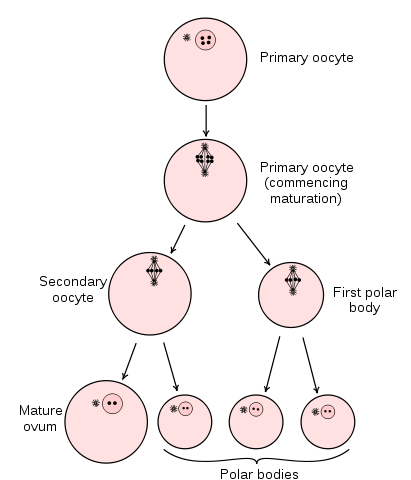17.81 鸡蛋槽 - 高级
章节大纲
-
What's amazing about this ?
::这有什么了不起的?Many things. A human egg cell. Just add and you have the necessary ingredients for a new baby. What's amazing about these cells is that they are all produced before the girl is even born. Before the girl is born, plans for the next generation have begun. And that is the start of an amazing process.
::许多东西, 人类鸡蛋细胞, 只要添加并且你有新婴儿的必要成分。 这些细胞的惊人之处在于, 它们都是在女孩出生之前产的。 在女孩出生之前, 下一代的计划已经开始了。 这就是一个惊人过程的开始。Egg Production
::鸡蛋生产At birth, a female’s ovaries contain all the eggs she will ever produce. However, the eggs do not start to mature until she enters . After menarche , one egg typically matures each month throughout a female’s adult years until she reaches middle adulthood .
::母卵子在出生时就包含所有她会生产的卵子。 然而,卵子在进入之前不会开始成熟。 在经经期之后,母卵在成年后每个月都会成熟,直到成年。Oogenesis
::来源来源Oogenesis is the process of producing eggs in the ovaries. Eggs are haploid cells, having half the number of of other cells in the body, which are diploid cells. Like sperm, eggs must be haploid in order for to result in a diploid offspring. Like spermatogenesis , oogenesis occurs in several steps that involve different types of cells. The steps of oogenesis are listed in Table .
::卵的产生过程是卵巢中产卵的过程。卵是杂交细胞,其数量为身体中其他细胞的一半,即低脂细胞。与精子一样,卵必须杂交才能产生低脂后代。与精子产生一样,卵的产生在多个步骤中发生,涉及不同种类细胞。卵的产生步骤在表格中列出。Oogenesis begins when an oogonium (with the diploid number of chromosomes) undergoes to form primary oocytes (also with the diploid number of chromosomes). Oogenesis proceeds as a primary oocyte undergoes the first of to form secondary oocytes with the haploid number of chromosomes. More information on meiosis can be found in the Meiosis chapter. A secondary oocyte undergoes the second meiotic cell division to form a haploid ovum if it is fertilized by a sperm.
::生成开始于一个(与染色体的dipoloid数量)开始形成一个原生卵细胞(也与染色体的dipoloid数量) 。 生成于一个原生卵细胞的收益开始于第一个形成第二代卵细胞的卵细胞。 更多有关美化的信息可以在 Meisisc 章节中找到。 二级卵细胞经历于第二个线性细胞分区, 如果精子受精, 则形成一个phanloid 卵巢。Oogenesis and Cell Division Type of Cell Number of Chromosomes Process Oogonium Diploid Mitosis Primary oocyte Diploid Meiosis 1 Secondary oocyte Haploid Meiosis 2 Ovum (mature egg) Haploid Oogenesis begins with oogonia (singular, oogonium), which are the immature eggs that form in the ovaries before birth. Oogonia are diploid cells and are equivalent to spermatogonia in males. By about the fifth month of fetal , the ovaries contain about seven million oogonia.
::Oogonia( singal, ogonium)是卵巢中出生前形成的不成熟的卵,Oogonia是浸泡细胞,相当于雄性精子。大约在胎儿的第五个月,卵巢中含有大约700万Oogonia。Over the next few months, oogonia undergo mitosis, forming cells called primary oocytes. Primary oocytes are also diploid cells. Before birth, primary oocytes begin the first division of meiosis, but they do not complete it until long after birth. At birth, the average female has about two million primary oocytes in her ovaries. Throughout childhood , the number of oocytes falls as they deteriorate and disappear. By puberty, there are only about 300,000 to 400,000 primary oocytes left in the average girl’s ovaries. Primary oocytes are halted in prophase of meiosis I until they are stimulated by FSH (follicle-stimulating hormone) after puberty.
::在接下来的几个月里,Oogonia会经历分裂症,形成称为初级卵细胞的细胞。初级卵细胞也是低卵细胞。在出生前,初级卵细胞开始第一种细胞分裂,但直到出生后很久才完成。在出生时,平均雌性在其卵巢中约有200万个主要卵细胞。在整个童年,卵细胞在恶化和消失时会下降。在青春期时,女孩的平均卵巢中仅剩下大约30万至40万个初级卵细胞。初级卵细胞在妊娠后被FSH(刺激性激素)刺激之前,在I类细胞的预发芽期停止了。Oogenesis. Oogenesis begins before birth, but is not finished until after puberty. A mature egg forms only if a secondary oocyte is fertilized by a sperm. Maturation of a Follicle
::熔冰的成熟期Beginning in puberty, one of the follicles starts to mature every month ( Figure ). The primary oocyte in the follicle resumes meiosis and divides to form a secondary oocyte and a smaller cell called a polar body . Both the secondary oocyte and the polar body are haploid cells. The secondary oocyte has most of the cytoplasm from the original cell and is much larger than the polar body. The polar body disintegrates and disappears from the ovary. The secondary oocyte is arrested at metaphase of meiosis II.
::从青春期开始,每个月有一个卵蛋开始成熟(图 ) 。 卵蛋中的主要卵细胞恢复了 meisic, 并分裂成一个二级卵细胞和一个叫做极体的较小细胞。 二级卵细胞和极体都是手动细胞。 二级卵细胞与原始细胞相比, 大部分的细胞都是细胞细胞, 比极体大得多。 极体分解后从卵巢中消失。 二级卵细胞在二号细胞的元阶段被捕 。Maturation of a Follicle and Ovulation. A follicle matures and its primary oocyte (follicle) resumes meiosis to form a secondary oocyte in the secondary follicle. The follicle ruptures and the oocyte leaves the ovary during ovulation. What happens to the ruptured follicle then? (a) primary follicle, (b) secondary follicle, (c) vesicular follicle, (d) ovulation, (e) corpus luteum forms, (f) regression, (g) corpus albicans. Ovulation
::排导Ovulation is the release of a secondary oocyte by an ovary. Ovulation occurs every 28 days, on average, in a sexually mature female, but may range normally from 24 to 36 days. As shown in Figure , during ovulation, a secondary oocyte bursts out of its follicle and through the ovary wall to enter the abdominal cavity.
::卵巢的卵巢释放是二次卵细胞,平均每28天一次对成年女性进行卵细胞排卵,但通常为24至36天。如图所示,在排卵期间,从卵囊中和通过卵巢壁抽出一个二次卵细胞,进入腹腔。Each month, only one of the ovaries matures a follicle and releases an egg. Which ovary matures a follicle in a given month? Scientists say that it appears to be random.
::每个月,只有一个卵巢会成熟一个卵蛋,并释放出一个蛋。哪个卵巢在一个月里会成熟一个卵囊?科学家说,这似乎是随机的。After the secondary oocyte leaves the ovary, it is swept into the Fallopian tube by the waving, fringe-like end. Tiny hairlike projections, called cilia , line the tube and help move the oocyte through to the uterus . If the secondary oocyte is fertilized by a sperm as it is passing through the Fallopian tube, it divides to form a mature egg and a polar body, finishing meiosis. (As before, the polar body contains very little cytoplasm and disintegrates.) If the secondary oocyte is not fertilized, it passes into the uterus as an immature egg.
::二次卵细胞离开卵巢后, 它被挥舞的边缘的边缘端扫入瀑布管中。 小毛状的投影, 叫做 cilia, 线条, 帮助将卵细胞移到子宫中。 如果二次卵细胞在通过Fallopian管时被精子施肥, 它会分裂成一个成熟的蛋和一个极体, 完成美化 。 ( 如前所述, 极体包含非常小的细胞托盘和分解。 ) 如果次卵细胞没有受精, 它会作为一个不成熟的卵子传入子宫。 ) 如果二次卵细胞没有受精, 它会作为不成熟的卵子传入子宫。An Egg Entering the Fallopian Tube. After ovulation, the fringe-like end of the fallopian tube sweeps the oocyte inside of the tube, where it begins its journey to the uterus. Summary
::摘要-
Eggs are haploid cells, having half the number of chromosomes of other cells in the body, which are diploid cells.
::蛋是杂交细胞,其体内其他细胞的染色体数量的一半,即浸泡细胞。 -
During oogenesis, oogonia become primary oocytes, which then become secondary oocytes, and finally become mature egg cells if fertilized by sperm.
::在产卵期间,Oogonia成为主要卵细胞,然后成为二级卵细胞,如果精子受精,最终成为成熟的卵细胞。 -
Beginning in puberty, one of the follicles starts to mature and eventually undergoes ovulation every month.
::从青春期开始,一个卵蛋开始成熟, 最终每月排卵一次。
Review
::回顾-
When do primary oocytes begin meiosis?
::初生卵细胞什么时候开始结扎? -
When are polar bodies produced during oogenesis?
::北极体何时产生? -
How does the oocyte get to the uterus?
::卵细胞是如何到达子宫的?
-
Eggs are haploid cells, having half the number of chromosomes of other cells in the body, which are diploid cells.



